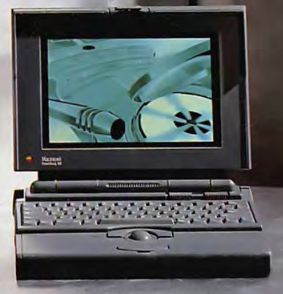
Apple PowerBook 180
The PowerBook 180 was the high end model of Apple's 1992 PowerBook lineup. It used a faster processor than the PowerBook 170 which it replaced, along with featuring a 16-shade grayscale TFT display instead of the 170's monochrome panel.
Specifications
| Spec | Details |
|---|---|
| Release Date | October 1992 |
| Discontinuation Date | May 1994 |
| Processor | Motorola 68030 @33MHz FPU: Yes Bus Speed: 33MHz |
| RAM | PowerBook 160/180 Proprietary Standard: 4MB Maximum: 14MB |
| Hard Disk | 2.5" SCSI Standard: 80 or 120MB |
| Display | 9.8" Active Matrix Grayscale (16-shades) LCD @640x400 |
| GPU | Chips & Technologies VRAM: 512KB |
| Main Battery | NiCad |
| PRAM Battery | VL2330 Lithium (Soldered) |
| Power Supply | Barrel Jack - 7.5V 2A - Apple M5651 |
| Disk Drives | 3.5" 1.44MB Floppy Drive |
| PC Cards | None |
| Networking | Modem |
| Other I/O | - 2x Serial - 1x HDI-30 SCSI - 1x Apple Desktop Bus - 1x Mini-15 Video Out - 1x Mic In - 1x Line Out |
| Pointing Device | Trackball |
| Minimum Mac OS | System Software 7.1 |
| Maximum Mac OS | Mac OS 7.5.5 |
Upgrades
SSD Upgrade
See our page on SCSI SSDs for more info.
Resources
 Service Manual |
Capacitor Reference |
|---|
Common Faults & Maintenance
The PowerBook 180, like other 100 series laptops, suffers from many different issues.
Broken Plastic
The plastic parts on the 180 have shrunk very slightly with time. As plastic can't shrink around the brass inserts inside every screw mount, these pretty much all crack and break. Do not confuse this with the brittle plastic disease that affects most laptops from the 1990s - these plastics are otherwise far more solid. The main mounts that break will be the ones for the hinges, and the ones for the drive cage.
Hinge Fixing
Multiple methods can be used to prevent and fix these weak screw mounts. The one I'd recommend the most is to replace the old brittle mounts with new 3D-printed ones. These new mounts include a large plastic plate that mounts behind the LCD, in order to allow extra area for the part to be glued to, and to relieve stress from the mounts themselves. These parts when applied correctly are very strong and last a long time.
Another method of repair if you don't have access to a 3D printer is epoxy. Lots of epoxy. This method works best if the original mounts are still intact, as otherwise they can be very difficult to reassemble. The idea is that you put a bunch of plastics epoxy around all of the mounts, in order to prevent them from breaking, and to add extra rigidity to the area. This can work when done right, but I'd still recommend the 3D printing approach if possible.
LCD "Tunnel Vision" Failure
The 180's TFT display is affected by the tunnel vision defect, which causes the corners of the screen to darken as the panel is used. The defect is extremely common on the 180, and it is not very difficult to find one with an unaffected panel.
Hard Drive Failure & Repair
These PowerBooks used SCSI 2.5" drives, which are pretty tough to find nowadays. If you do have a dead drive, I'd recommend replacing it with a modern solid state solution instead of paying silly money for spinning rust off eBay. Multiple options are available, and more info is available here.
Battery Leaks
The main battery for the 100 series PowerBooks is NiCad based, so they leak pretty frequently. Don't leave an intact one in your laptop, and make sure to check any unit you get your hands on for one. Usually the logic board only ends up damage in the event of a pretty severe leak luckily. Also, if the battery has shorted (which is pretty common), the laptop won't start with it installed. If you have a known-good AC Adapter and your PowerBook is acting dead, there's a good chance that's why.
The PRAM battery in the 180 is a rechargeable Lithium coin cell. These rarely leak. Still probably a good idea to remove it if you get the chance though, but be warned, it is soldered right to the internal interconnect board, so getting it out is a bit of a pain.
Power Supply Failure
The original external PSU for these laptops uses ELNA Long-Life caps inside, which are well known to leak the worst out of just about any brand. They just love to barf their guts out all over the place in anything they're installed on and cause a real mess. They're what's behind the Mac IIsi PSU's awful reputation, and there are a couple of them inside the 100 Series PSU. So yeah, recapping them is pretty much required at this point. Getting one open is a challenge though, as you pretty much have to break it open. A vice and a couple of pencils is the best way I know to do this, and will usually get them to pop without much damage.
If you wouldn't like to bother with any of that, and I can't blame you if you don't, another option is to get an inexpensive replacement off of Amazon or eBay. The voltage and barrel jack requirements for these are so simple that replacements are still available.
Page last updated (MM/DD/YYYY): 03/03/2025
Update Reason: page rewritten
Back-Navigation
Home < Macintosh Portal < PowerBook < PowerBook 180